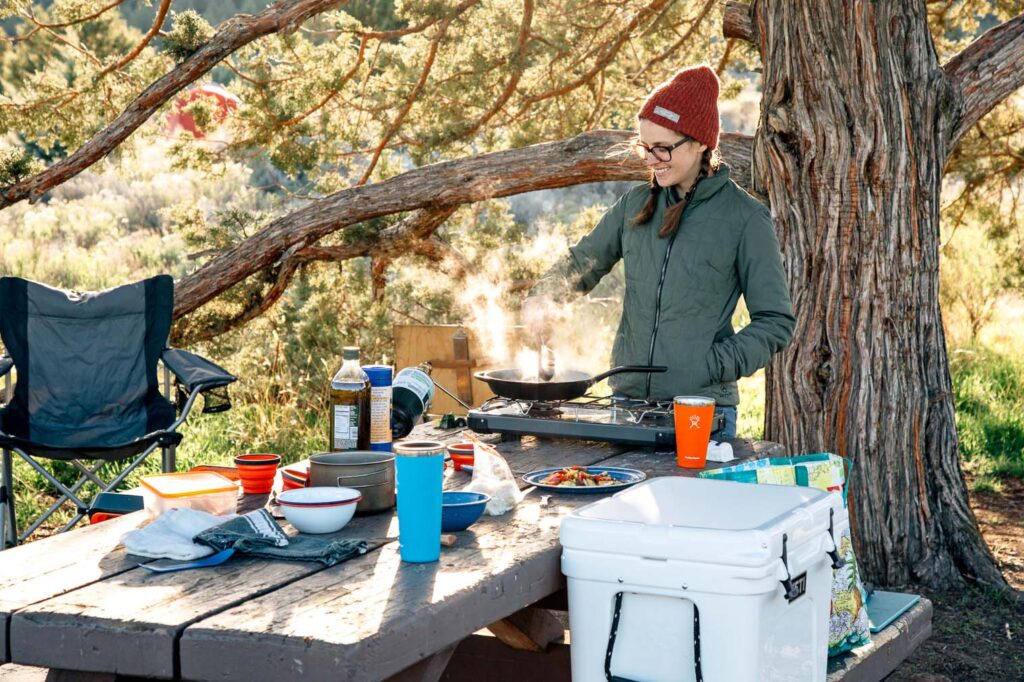Uncategorized
How to Organize Your Camping Kitchen: Tips and Tricks
A well-organized camping kitchen can make a world of difference when you’re out in the wilderness. Whether you’re cooking meals over an open fire or using a portable camping stove, the key to a stress-free and enjoyable camping experience is efficiency. An organized kitchen saves you time, reduces stress, and ensures that you have everything you need when it’s time to prepare meals.
If you’ve ever struggled with finding your spatula or dealing with a cluttered cooking area, don’t worry—you’re not alone! In this guide, we’ll provide tips and tricks on how to organize your camping kitchen, ensuring that your meals are cooked easily and your gear is always in the right place.
1. Choose the Right Storage Containers
One of the most crucial aspects of organizing your camping kitchen is using the right storage containers. Properly storing your food, utensils, and cooking gear will help you avoid spills, keep your gear organized, and protect your food from pests.
- Food Containers: Opt for airtight containers to keep your food fresh and safe from critters. Stackable plastic or silicone containers are great for compact packing and easy access. For dry foods like pasta, rice, and cereal, use resealable bags or vacuum-sealed storage to save space.
- Utensil and Tool Storage: Invest in a compact toolbox or a gear organizer bag for your cooking tools. This helps keep utensils, knives, and small gadgets from getting lost in the mess. Look for waterproof or at least water-resistant bags for added durability.
- Coolers: A good cooler is essential for keeping perishables fresh. Use a high-quality cooler with insulation, and pack it smartly. Consider using separate coolers for drinks and food to make it easier to access what you need.
Pro Tip: Label each container with its contents or purpose (e.g., “spices,” “snacks,” or “dinner prep”) to save time searching for items.
2. Pack for Efficiency: Group Like Items Together
When organizing your camping kitchen, it’s helpful to group like items together so you can access everything you need quickly. This reduces the time spent digging through bags and helps you stay on track when preparing meals.
- Cooking Gear: Store all of your cookware—pots, pans, spatulas, tongs, and can openers—together in a single compact cooking gear bag. This will help you avoid packing excess and ensure everything is organized.
- Eating Utensils: Keep your plates, bowls, cups, and eating utensils together in a separate bag or container. You can even use collapsible bowls and cups to save space.
- Spices and Seasonings: A small spice kit or an old pill container can be an easy way to organize small bottles of salt, pepper, and other essential seasonings. This way, you don’t need to bring entire spice jars that will take up precious packing space.
- Cleaning Supplies: Pack a separate bag or small bin for cleaning items like biodegradable soap, dish towels, sponges, and trash bags. Keeping these together ensures you can clean up your cooking area efficiently.
3. Invest in Multi-Use Cooking Tools
Instead of packing a different tool for every task, opt for multi-functional items that can serve several purposes. This will reduce the number of utensils and tools you need to bring while maximizing space.
- Camping Pots and Pans: Look for a nesting cookware set that includes a pot, pan, and possibly even a kettle, all of which can stack inside each other to save space.
- Spork: A spork (a combination of spoon and fork) is a lightweight and versatile utensil that works for most meals. Consider packing a few of these instead of bringing separate spoons, forks, and knives.
- Knife with Multiple Functions: A multi-tool knife or a survival knife can handle food prep tasks, as well as other utility needs like cutting rope or opening cans.
Having tools that can serve multiple purposes helps streamline your kitchen setup, reduce clutter, and simplify your packing process.
4. Set Up an Outdoor Cooking Station
Setting up a dedicated cooking area can help you stay organized and focused when it’s time to prepare meals. Here are some tips for creating an outdoor kitchen that maximizes space and efficiency:
- Camp Kitchen Table: If you have the space and gear, a portable camp kitchen table is perfect for organizing your cooking station. These often come with built-in shelves, hooks, and counter space, allowing you to keep your cooking tools, stove, and prep items close by.
- Use Vertical Space: If you’re short on space, look for camping storage racks or hanging organizers that can hold items like pots, pans, and utensils. You can also hang your cooler, trash bags, or even a lantern for extra light.
- Fire Safety: If you’re cooking over an open flame, ensure your camp kitchen is set up a safe distance from your tent or any flammable materials. Use fireproof mats or grill pads to protect the ground and prevent burns.
- Organize by Cooking Stage: Set up your station into different zones: one for prepping food, one for cooking, and one for cleaning. This separation makes the cooking process more efficient and keeps your area less cluttered.
5. Streamline Meal Planning
One of the easiest ways to keep your camping kitchen organized is by planning your meals ahead of time. This way, you’ll know exactly what to pack and when to use each ingredient, reducing the chances of bringing unnecessary items or forgetting something important.
- Pre-Meal Prep: Prepare as much as you can before your trip. Pre-chop vegetables, marinate meats, or measure out dry ingredients like flour, rice, and oats. Store them in labeled containers to make meal prep at camp quicker and easier.
- One-Pot Meals: Choose recipes that require minimal cookware or can be made in a single pot or pan. One-pot meals are perfect for reducing cleanup and minimizing the gear you need to pack.
- Portable Grilling: If you’re grilling, pack pre-seasoned or pre-cooked meats and vegetables that only need to be heated up. A portable grill or campfire grill grate can also make cooking and cleaning more efficient.
Pro Tip: Plan meals that allow for leftovers. This reduces the number of times you’ll need to cook, helping you conserve fuel and saving you time.
6. Keep It Clean and Tidy
A clean camp kitchen not only ensures better hygiene and safety but also improves the overall camping experience. Here’s how to keep your cooking area tidy:
- Clean as You Go: Instead of leaving everything for after-meal cleanup, wash dishes and clean up spills immediately. This reduces clutter and prevents the buildup of grease and grime.
- Trash Bags: Always bring extra trash bags to dispose of wrappers, food scraps, and used items. Keep one designated bag for recyclables and one for trash. Consider using biodegradable bags to reduce your environmental footprint.
- Organize Cleaning Supplies: Pack your cleaning supplies (dish soap, sponges, and paper towels) in a waterproof, resealable bag to prevent them from getting dirty or lost in your pack. Make sure you clean your cookware thoroughly to prevent attracting pests.
7. Use Ziplock Bags and Packing Cubes
Ziplock bags are one of the most versatile tools for organizing your camping kitchen. You can use them to store food, utensils, or even separate different ingredients to prevent cross-contamination. Packing cubes are also great for organizing smaller items like seasonings, snacks, and cooking tools. Both options help maximize space and minimize mess.
Conclusion
Organizing your camping kitchen effectively can drastically improve your camping experience, making it easier to prepare meals, keep things clean, and enjoy your time outdoors. By using the right storage containers, grouping similar items together, investing in multi-use tools, setting up a dedicated cooking station, and planning your meals ahead of time, you’ll have a functional and efficient kitchen in no time.
Remember, the goal is to minimize clutter, maximize space, and make meal prep as smooth as possible so you can focus on enjoying your outdoor adventure. Happy camping, and may your meals be as enjoyable as the journey itself!

